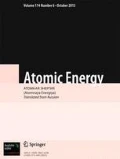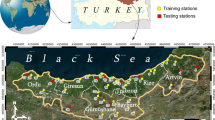To analyze the reasons for the high radioactive contamination of the Techa River in August 2004, when the 90Sr content in the section line at the village of Muslyumovo exceeded 50 Bq/liter, the dynamics of the concentration of 90Sr in Techa River water and the level of the reservoir V-11 were modeled using artificial neural nets. It is concluded that there exists a hidden factor, which is activated at definite times, substantial decreasing the water level in the reservoir V-11, and that cannot be explained on the basis of the precipitation-evaporation balance. The action of this factor is strongly associated with the change of the water flow rate in the left-bank channel. It is suggested that the high radioactive contamination of the Techa River in the summer of 2004 coinciding with the decrease of the water level in V-11, which cannot be explained by the precipitation-evaporation balance, are associated with a discharge of the contaminated water from V-11 into the left-bank bypass.
Similar content being viewed by others
References
V. I. Sadovnikov, Yu. V. Glagolenko, E. G. Drozhko, et al., “Current status and solution of the problems of the Techa reservoir cascade,” Vopr. Radiats. Besop., No. 1, 3–14 (2002).
Yu. G. Mokrov and D. M. Shagin, “Study of the regularities of the transfer of suspended particles contaminated with radionuclides with the Techa River flow in the period from 1949 to 1951,” ibid., No. 1, 18–31 (2001).
Yu. G. Mokrov and D. M. Shagin, “Construction of a hydrodynamic model of the Techa River for calculating the transport of suspended particles,” ibid., No. 2, 71–73 (2002).
S. Lee and J. Guegan, “Artificial neural networks as a tool in ecological modeling, an introduction,” Ecol. Model., 120, No. 2–3, 65–73 (1999).
C. Dawson and R. Wilby, “Hydrological modeling using artificial neural networks,” Prog. Phys. Geography, 25, No. 1, 80–108 (2001).
V. V. Kruglov and V. V. Borisov, Artificial Neural Nets: Theory and Practice, Moscow (2001).
N. V. Yakshina, Neural-Net Modeling of the Processes Resulting in the Contamination of the Environment, Candidate's Dissertation in Physicomathematical Sciences, Institute of Industrial Ecology, Ural Branch of the Russian Academy of Sciences, Ekaterinburg (2007).
Author information
Authors and Affiliations
Additional information
Translated from Atomnaya Énergiya, Vol. 105, No. 2, pp. 107–112, August, 2008.
Rights and permissions
About this article
Cite this article
Korobitsyn, B.A., Chukanov, V.N. & Yakshina, N.V. Artificial neural net modeling of the radioactive contamination of the Techa River. At Energy 105, 138–144 (2008). https://doi.org/10.1007/s10512-008-9077-y
Received:
Published:
Issue Date:
DOI: https://doi.org/10.1007/s10512-008-9077-y




